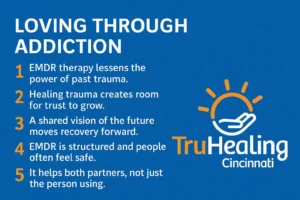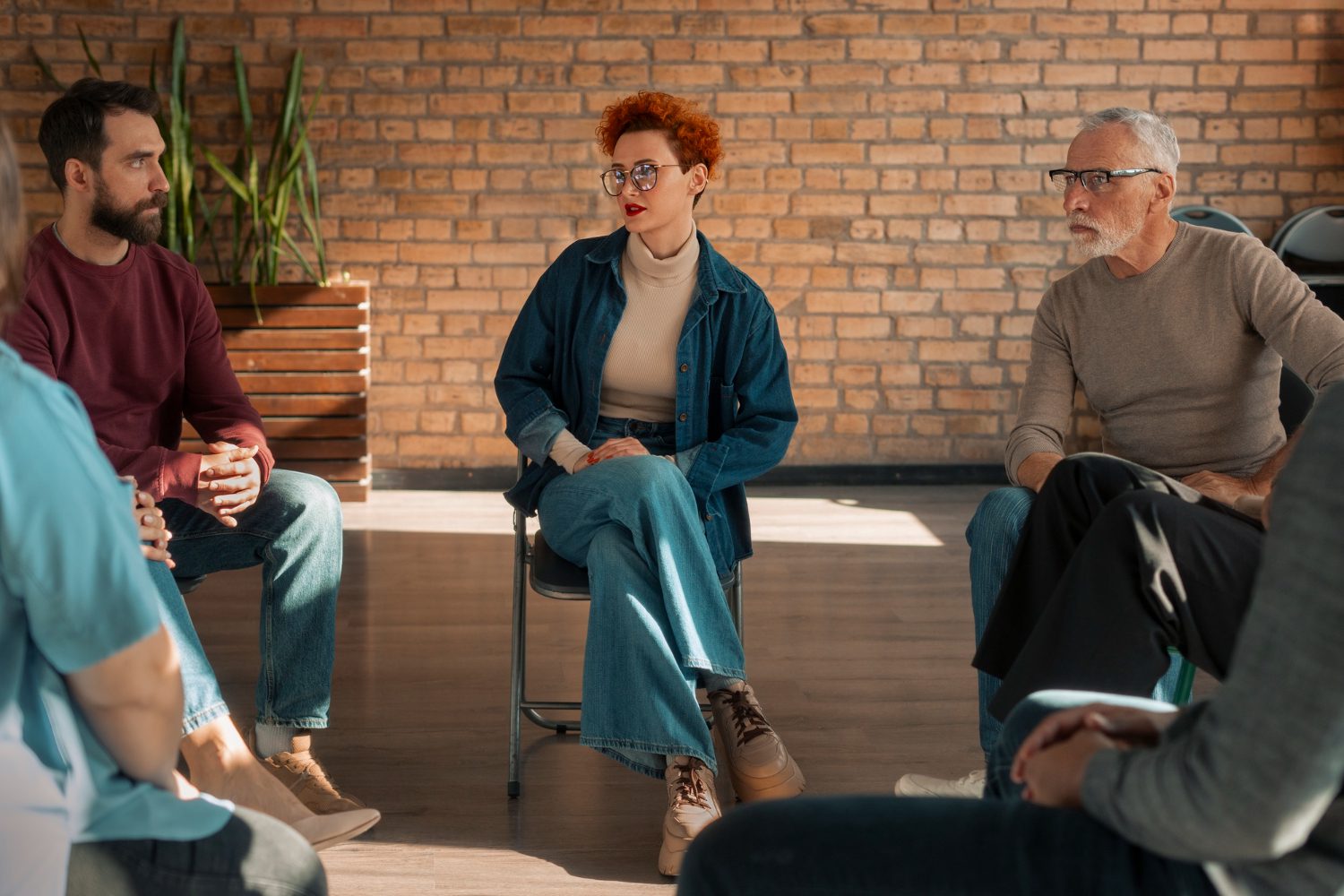Loving Someone Through Addiction
When you love someone who is actively using, the relationship can feel like a tug-of-war between memory and reality. You remember the laughter, the promises, the future you dreamed about together. Then you see the distance addiction has created, the lies, the missed dinners, the broken trust.
It’s a strange kind of love—full of loyalty but also full of exhaustion. You might feel guilty for wanting things to change, or guilty for not being able to “fix” it yourself. Nights stretch longer, arguments loop, and you wonder whether things can ever go back to the way they were.
But here’s the truth: addiction doesn’t have to be the end of your story together. Therapies like EMDR (Eye Movement Desensitization and Reprocessing) can help create something beyond survival. They can help you and your partner build a vision for life after addiction—one rooted in healing, trust, and connection.
What EMDR Really Is (and Isn’t)
EMDR is a trauma-focused therapy designed to help people process painful experiences so they no longer hold the same emotional power.
Here’s what it’s not:
- It’s not hypnosis.
- It’s not about erasing or “forgetting” memories.
- It’s not a quick fix that makes everything magically better.
Instead, EMDR helps the brain “reprocess” traumatic memories so they stop feeling like open wounds. Through bilateral stimulation (eye movements, tapping, or sound cues), the brain learns to refile traumatic events in a way that lessens their emotional charge.
For people struggling with addiction, this can be transformative. Because often, substance use is a way to numb the pain of unhealed trauma. When trauma loses its power, the need for numbing begins to lose power too.
Why Trauma Healing Matters in Relationships
Addiction rarely shows up in isolation. Beneath it, there are often layers of trauma—childhood abuse, grief, bullying, untreated mental health struggles. For partners, living with someone in active addiction creates its own trauma: broken trust, instability, and constant fear.
Both partners carry invisible wounds into the relationship. Without healing, those wounds shape the way you argue, avoid, or cling to each other. EMDR helps shift this.
By helping one or both partners reprocess trauma, EMDR reduces the emotional reactivity that often fuels conflict. That creates space for trust to slowly grow again. It moves the relationship out of “crisis mode” and into a place where imagining a future together becomes possible.

What a Shared Vision Looks Like
A shared vision doesn’t mean a picture-perfect relationship where everything is fixed. It means choosing healing, together, instead of surviving separately.
For couples navigating recovery, this can look like:
- Rebuilding daily trust with small, consistent actions.
- Learning to communicate without defensiveness.
- Making room for honesty, even when it’s hard.
- Dreaming about the future again—whether that’s raising a family, taking trips, or simply enjoying nights at home without chaos.
EMDR therapy helps clear the emotional clutter that gets in the way of that vision. By loosening the grip of past wounds, it creates room for connection to grow.
What EMDR Feels Like in Recovery
If you’re imagining something overwhelming, take a breath. EMDR is structured, safe, and led by a trained therapist who walks with you step by step.
The process usually involves:
- Preparation. Building safety and trust with the therapist.
- Targeting trauma. Identifying a memory or belief that still carries pain.
- Bilateral stimulation. Eye movements, taps, or sounds while revisiting the memory.
- Reprocessing. The memory loses its raw, painful intensity. It becomes something remembered, not something relived.
People often describe EMDR as finally being able to breathe around memories that once felt suffocating. The past doesn’t disappear—it simply stops dictating the present.
How EMDR Helps Both Partners
Even if your partner is the one struggling with substance use, you’ve lived through trauma too. Watching someone you love spiral, lie, relapse, or shut you out leaves scars. You may find yourself anxious when they don’t text back, quick to argue, or numb to your own feelings.
This is called secondary trauma—and it’s real. EMDR can help you as much as it helps your partner. Working through your own fears, resentments, or grief makes space for you to show up with more compassion and clarity.
When both partners are healing, the relationship begins to shift from survival to shared creation. You stop fighting against the past and start walking toward a future.
Stories of Hope: Healing in Motion
One alum shared that before treatment, she and her husband barely spoke without fighting. He was drowning in addiction; she was drowning in resentment. After residential treatment, he began EMDR to process the trauma that fueled his drinking. She started her own therapy for the years of fear she carried.
Six months later, they weren’t perfect. But they were hopeful. They had dinner together most nights. They laughed sometimes. They were planning a small trip, something they hadn’t done in years.
Their story isn’t rare. Couples who engage in trauma therapy often find that the relationship—once buried under layers of pain—can breathe again. EMDR didn’t erase their problems. It gave them the room to build new solutions together.
Taking the First Step Together
If your partner is actively using, it may feel impossible to think about the future. You’re tired. You’ve hoped before, only to be disappointed. But healing doesn’t demand you know the entire path ahead. It only asks for one step.
That step might be exploring EMDR therapy, reaching out to a treatment center, or simply saying aloud: “I want us to imagine a future together.”
At TruHealing Cincinnati, couples and individuals are supported through therapies that address both addiction and the trauma that drives it. That’s where real change begins.
FAQs About EMDR Therapy for Couples
1. Is EMDR only for people with PTSD?
No. While EMDR is widely known for PTSD, it helps with many forms of trauma: childhood wounds, grief, anxiety, or trauma tied to addiction.
2. Can partners do EMDR together?
Sessions are usually individual, but both partners can participate in their own EMDR therapy. Couples counseling can run alongside EMDR to strengthen the relationship.
3. Does EMDR replace addiction treatment?
No. EMDR works best as part of a broader recovery plan. It addresses the trauma, but residential or outpatient care provides the structure and support needed for sobriety.
4. How long does EMDR take to work?
It varies. Some people feel relief after a few sessions, while others take longer. Healing moves at the pace your brain and body are ready for.
5. Will EMDR make my partner stop using?
Not directly. But by healing trauma that fuels substance use, EMDR often reduces the need to self-medicate. Combined with treatment, it supports long-term recovery.
6. What if I don’t have trauma? Do I still need EMDR?
Many partners discover that they do carry trauma—whether from the relationship, childhood, or past losses. Even if you don’t, EMDR can still help reduce anxiety and improve resilience.
7. Can EMDR help rebuild trust in our relationship?
Yes. By lowering emotional reactivity, it creates safer ground for rebuilding trust. It doesn’t guarantee trust will return overnight, but it makes honest connection possible again.
Final Word: Healing Together Is Possible
Addiction might feel like it’s stolen your shared future. But therapies like EMDR can open the door to something new—not the same life you had before, but one rooted in honesty, healing, and hope.
Healing doesn’t mean forgetting the past. It means choosing to create space for the present—and daring to imagine a future together.
Take the Next Step Today
If you and your partner are ready to begin imagining life beyond addiction, TruHealing can help.
Call (888) 643-9118 or visit EMDR therapy services in Cincinnati, Ohio to learn how healing can begin for both of you.


